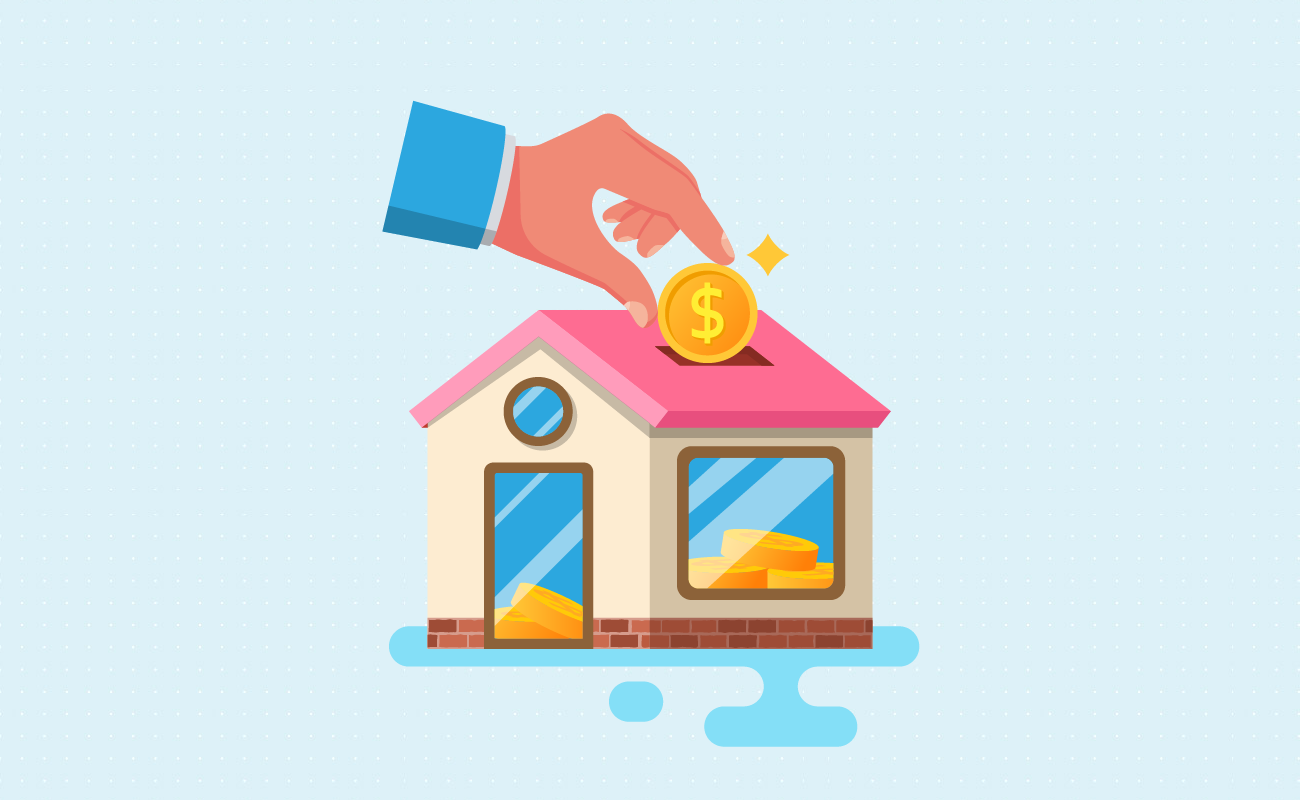 Residentail Income Property Analyzer
Residentail Income Property AnalyzerThis calculator helps property investors quickly calculate the potential viability of residential income property investments. Enter your property information and quickly calculate factors like:
Guide published by Jose Abuyuan on November 5, 2020

Part of securing your financial future depends on making worthwhile investments. And while there are numerous ways to grow your money, a 2019 Gallup survey reported that 35 percent of U.S. respondents said real estate is on of the best long-term options. Meanwhile, 27 percent mentioned stocks. If you have significant savings that you want to grow, it’s worth investing in income property.
Income properties can be residential or commercial real estate. Some of the most common income properties are single-unit homes and multi-family homes. If you’re planning to rent out your property while it appreciates, this is a type of income property investment.
Our guide will discuss how residential income properties work. We’ll talk about typical cap rates and what types of income property usually get higher or lower caps. We’ll also discuss how down payments can help you obtain a competitive rate for your mortgage. Then, we’ll give you a rundown of key ratios every real estate investor should know, as well as other important market information about residential income property investments.
Income property is a type of investment that is developed or purchased to earn income. This asset generates income through rental payments and when the property’s value appreciates. Income properties are also referred to as investment properties which come in the form of residential or commercial property investments.
Residential income properties are offered to renters for personal purposes. These include single-unit or multi-family homes, apartments, condominiums, and townhouses. It also includes vacation homes such as cottages. Meanwhile, commercial real estate is primarily used for business operations. These are office buildings, hotels, restaurant spaces, retail spaces, and mixed-use properties. For our article, we will mainly focus on residential income property.
An income property may be part of a primary residence. If you’re a homeowner, you have the option to rent out a portion of your house. For example, you can rent out extra rooms in your home, the basement, or the entire second floor. It allows you to earn income while living there. This arrangement is called an owner occupied income property, where the landlord and tenants reside in the same estate.
A non-owner occupied income property, on the other hand, is property that is primarily occupied by tenants. It is chiefly maintained by the owner to produce income. In this arrangement, the owner lives separately from the tenants.

Real estate investors typically borrow money from banks to finance residential income property. As with all loans, you must pay back a certain amount to your lender each month. The monthly payment will depend on the loan amount and the terms of your mortgage. And when you cover this cost, you can use income obtained from monthly rent payments.
Owning rental property can be a viable source of long-term income. However, maintaining it involves considerable costs. As the owner or landlord, you must have enough funds to cover regular repairs and keep the home or unit in serviceable condition. Though it may be costly, some property owners set aside at least 1 percent of their property’s value for maintenance. You are also responsible for paying property taxes, insurance, and utilities. Thus, you must ensure your cash flow exceeds the cost of taking a loan and maintaining the property.
With proper financial management, you can increase the return on your investment. And once your mortgage is paid down, you can anticipate much higher returns from your property. Over time, you can benefit from a significant increase in appreciation. Later on, you may resell your apartment building at a much higher price than your initial purchase.

The success of any residential income property lies on managing cash flow. Your earnings should exceed the money spent to repay your lender and preserve the property. Make sure you’re earning more money through rental payments to gain significant returns on your investment.
REIT or real estate investment trusts are corporations that own, manage, or finance income generating properties. They invest in a portfolio of real estate holdings and usually sell shares publicly. REIT shares behave like mutual funds for real estate investing and are bought and sold just like stocks.
You can invest in REITs without having to purchase or manage income property yourself. A REIT can provide high average dividends and is a liquid method of investing in real estate. Investors can buy them from brokers who provide advice on the best REIT for investment goals.
On the downside, since REIT shares are traded on an exchange, their value is sensitive to interest rate fluctuations. It can actually be more volatile than other real estate investments such as residential and commercial income property. Furthermore, while investing in REIT shares can help diversify your investment portfolio, individual REITs are really not diversified. Most REIT shares concentrate on a type of property, such as office buildings, shopping malls, or hotels. For instance, if you took a REIT that invests primarily on hotels, this would be negatively impacted during an economic downturn like the COVID-19 crisis. Such scenario subjects you to specific property risks.
On the other hand, if you want control over the property and have actual involvement with your holdings, you can directly invest in real estate. Purchasing your own income property allows you to take advantage of tax breaks. And since properties appreciate, you can sell it later for a higher price.
Just be sure to consider the scale and responsibility of directly owning investment property. You must qualify for financing to jumpstart your investment (managing your own property entails a large capital). It also requires your time and energy to handle operations. And finally, you must manage your finances properly to ensure your investment generates successful profits. For investors who are ready to do the work, owning income property is a worthwhile venture.
One of the most common ways to gauge a property’s investment potential is by determining capitalization rate, also called the “cap rate.” This key metric is commonly used for commercial property investments but can also be used for residential income properties.
The cap rate is a calculation of your income property’s annual rate of return. This shows how much you’ll potentially gain or lose, indicating whether or not it’s a good investment. Note that a cap rate does not provide the exact amount you stand to gain. However, it’s still a good estimate of how much you might earn.
There are different ways to estimate cap rate, but this basic formula is used by most investors:
Cap Rate = Net Operating Income / Current Market Value
Where:
Next, once you’ve calculated your net operating income, divide it by the property’s current market value to obtain the cap rate. For this example, let’s say you’re about to purchase a property for $1M with an estimated net operating income of $80,000. Your resulting rate cap will be 8 percent.
Cap Rate = $80,000 / $1,000,000
= 0.08
= 8%
According to Nolo, a reasonable range to earn income from your property is around 4 to 10 percent return per year. Other sources might also say 4 to 12 percent. While there is no definitive figure for a good cap rate, it is largely dependent on factors such as the type of property and location. The quality of the property also matters. For instance, a class A property (any unit with high quality) has higher cap rates than class B or C. Meanwhile, the location is tied to the demand for rental properties in an area.
Asset classes compare residential units of similar value based on the property’s age and quality. The following is a typical breakdown of asset classes for multifamily housing units:
Cap rates represent different levels of risk for lenders and investors. A lower cap rate suggests lower credit risk, while a higher cap rate implies higher risk. There is no ideal cap rate because it depends on the investor’s risk preference.
To give you an idea, here’s an example. The following are average cap rate ranges for different real estate investment properties in Austin, Texas. The data is taken from the CBRE’s U.S. Cap Rate Survey Report for Q3 of 2020.
| Property Type | Average Cap Rate Range |
|---|---|
| Multi-family (Urban) | 3.75% – 4.25% |
| Multi-family (Suburban) | 4.00% – 4.50% |
| Office (Urban) | 5.75% – 6.25% |
| Office (Suburban) | 6.75% – 7.50% |
| Retail | 5.25% – 6.00% |
| Industrial | 5.25% – 6.00% |
*The figures are based on Stabilized Class A Cap Rates
In the example, the highest cap rate is for suburban offices in Austin, which ranged between 6.75 to 7.50 percent. Meanwhile, the lowest cap rate is for multi-family apartments in urban areas, which ranged from 3.75 – 4.25 percent.
Generally, we see much lower cap rates in cities and metropolitan areas than in urban or rural areas. This is consistent with the example above, with the lowest cap rate found in multi-family homes located in the city. Cap rates are especially lower in large coastal cities such as San Francisco, Los Angeles, and Seattle.
Lower rate caps represent higher market value and lower risk for investors. Residential income property cap rates are also generally lower compared to commercial investment properties, which are costlier to operate and maintain. Meanwhile, higher cap rates reflect greater investment risk. It may also indicate lower market value for properties in less lucrative locations (e.g. a shabby part of town, a rural area, etc.).
Investors rely on financial analysis to determine a property’s potential for profit. This helps them estimate if a particular estate can generate good cash flow, deliver an adequate rate of return, and eventually sustain profitability.
Careful financial analysis helps investors decide if it’s worth investing in a property. Because this is a fundamental step, many basic financial ratios or formulas are commonly used by investors. Apart from the capitalization rate, it’s crucial to check different kinds of financial indicators.
Here’s a rundown of key ratios you should consider before investing in income property:

OCF = Cash Flow from Current Operations / Current Liabilities
The operating cash flow ratio (OCF) is a liquidity ratio which measures how well you can cover your current debts (liabilities) using cash flow generated by your property. It shows how much your investment earns per dollar of current liabilities. For businesses, OCF indicates the amount of cash a company produces exclusively from its business operations. Because your earnings are bound to accrue, you can reallocate these funds as you see fit.
The cash flow ratio is considered an essential metric for determining your property’s short-term liquidity. A ratio of less than 1 signifies short-term cash flow problems, while a ratio greater than 1 suggests good financial standing. A ratio over 1 indicates your cash flow is more than adequate to satisfy short-term financial responsibilities.
On the other hand, a property that fails to obtain a positive OCF cannot stay solvent in the long term. A negative OCF shows that an income property is not producing sufficient revenues from rent. Thus, it needs to generate additional cash flow either from financing or other investment activities.
Price-to-Rent Ratio = Median Home Price / Median Annual Rent
Investors use the price-to-rent ratio to help them determine the best locations to buy rental property. It’s also used to analyze investment opportunities. The price-to-rent ratio is a metric which divides the median property price by the annual rent cost in an area. For renters, it’s used to verify if it’s better to buy a house or keep renting in a neighborhood. It also gauges if housing prices are fairly valued or overpriced.
When renters calculate this ratio, the result is generally classified into three ranges:
The price-to-rent ratio gives insight into how lucrative residential real estate is for an area. For instance, if the ratio is low for a location, more people are likely to buy a house. Thus, it’s not sensible to purchase an apartment building in this area. On the other hand, if the price-to-rent ratio is particularly high, it’s a good sign that shows more people are turning to the rental market.
GRM = Market Value (Price) / Gross Annual Rent
The gross rent multiplier (GRM), also called gross revenue multiplier, is the ratio of the property’s price to its gross rental income. The GRM is the price of the real estate investment to its annual rental income before costs such as insurance, property taxes, and utilities. GRM also estimates the number of years the property will take to pay for itself through received gross rent.
For instance, let’s suppose a rental property worth $200,000 will produce a monthly rental income of $2,300. Multiply $2,300 by 12, and you’ll get the annual gross income which is $27,600. To calculate GRM, divide $200,000 by $27,600. Your resulting GRM will be 7.25.
Based on the example, your pay off ratio will take 7.25 years or 87 months. Now, you can use this value to compare it to the average GRM in an area.
As a general rule of thumb, property with lower GRM suggest a potentially lucrative a deal. This also means that it will take less time to pay off its property price. Market experts typically recommend a GRM range between 4 to 7.
On the other hand, because it deals with gross income, GRM does not account for operating costs. This metric cannot differentiate income properties with lower or higher operating expenses. That’s why it is often used in relation to other financial metrics. A property with lower GRM may still have high operating costs that can keep you from earning more income. To keep your pay off ratio short, it’s ideal to obtain a property with low GRM.
ROI = Current Value of Investment – Cost of Investment / Cost of Investment
The return on investment ratio (ROI) is a profitability metric that calculates the performance or potential return from an income property. This measures the amount of return on your investment relative to its cost. The ROI ratio allows property owners to estimate how efficiently their investment can generate income. Companies also use ROI to measure the success of a specific business project. If the money generated exceeds the amount spent, it is considered an acceptable ROI. To calculate ROI, the return on an investment (net profit) is divided by the cost of the investment.
If an investment’s ROI is positive, it usually suggests a worthwhile investment. Likewise, investors should steer clear of negative ROIs which indicate net loss. Since ROI is a ratio expressed in percentage, you can easily compare it with returns from other types of investments. This helps you track how profitable one form of investment is against another.
As a general rule, investors can anticipate a high ROI if one or both of these conditions are met: If the cash flow is high and if the investment basis is low. The idea is if you generate a lot of income from a small capital investment, it’s most beneficial for your business.

NIM = Property Market Price / Net Operating Income
The net operating income (NIM) is an indicator that represents the amount an investor would pay for each dollar of net operating income (NOI). It’s useful for measuring how effective a property is in generating income compared to its market price. If you’ve calculated your capitalization rate, the NIM is just the reverse or reciprocal of the cap rate.
You can also rearrange the NIM formula to obtain the property market price as follows:
Property Market Price = Net Income Multiplier x Net Operating Income
For example, let’s say you’re buying an apartment building priced at $2,500,000. Your broker confirms that the net operating income is $400,000. To calculate NIM, divide $2,500,000 by $400,000. The resulting NIM will be 6.25.
A NIM of 6.25 tells investors that the price is around 6 and 1/4 times greater than the income generated by the property. This also tells us how well the property can produce income compared to its market price. You can also use this indicator to compare it with other properties in a market.
Next, let’s say you want to find the market price of another property. You’re looking at an apartment building with a net operating income of $200,000. Comparable apartments in the area are selling for 12 times their net operating income. With this information, you can estimate the market price of the apartment building. Just multiply the net operating income ($200,000) with the net income multiplier (12). The resulting market price will be $2,400,000, which is slightly lower than the first example.
Generally, the lower the NIM, the better. This indicates that the net operating income earned by the property is higher than the percentage of the price paid by the investor to purchase the property. To get an accurate NIM estimate, make sure to verify if the cap rate and purchase price are current local values in an area.
COC = Annual Pre-tax Cash Flow / Total Cash Invested
The cash on cash return ratio is a rate of return that calculates the total cash earned on the total cash invested on a property. The total cash earned is typically based on an annual pre-tax basis. This metric measures the annual return an investor made on their property relative to the amount of mortgage they paid within the year.
Cash on cash return is also sometimes called the cash yield in a property investment, which indicates real estate investment performance. You can calculate the pre-tax cash flow by getting earnings on your annual rent and subtracting all the cash outflows, which include your mortgage’s principal and interest payments.
Note that cash on cash return does not account for debt, which means it only calculates the actual cash amount invested. This allows investors to measure the return of a current period, which is usually per year instead of the entire life of the investment. This is a more precise result that reflects the investment’s performance within a year.
On the other hand, because pre-tax cash flow is factored in the calculation, you should be aware of the tax treatment on your investment. If your cash on cash return is low, high taxes can cancel any potential returns on your investment. With cash on cash return, a more leveraged investor typically gets a higher ratio. But note that as leverage increases, so does risk of default as it becomes more difficult to repay your debt.

LTV = Loan Amount / Property’s Appraised Value
Loan-to-value ratio is a measure that compares the amount of a loan to the value of the purchased asset. This ratio is commonly used by banks to determine how much risk they are taking when they secure a mortgage. A higher LTV ratio presents greater potential loss for lenders. Primary factors that impact LTV ratio are the amount of your down payment, the property’s sale’s price, and the appraised value of the property.
When buying investment property, your LTV ratio will indicate whether or not you need to pay private mortgage insurance (PMI) on your mortgage. Owner-occupied residences backed by conventional loans, are generally assigned loans with 80 percent LTV. If your LTV is higher than 80 percent, you are required to pay PMI. Once your LTV reaches 78 percent, PMI is cancelled.
On the other hand, lenders usually require a lower LTV for income property. For residential income properties, the LTV ratio can be as low as 75 percent for a 4-unit housing. Properties with more than 4 units are regarded as commercial properties, which can have an LTV ratio of 75 percent up to 80 percent.
The LTV ratio also shows how much equity you have on a property. For instance, if your property's price is $300,000 and your down payment is $50,000, your LTV is 83.33 percent. This means you have 16.66 percent equity on the property.
How much down payment should you make? To finance a residential property as an investment property, you typically need to pay at least 20 percent down for a conventional mortgage. However, this depends on the lender, with some requiring up to 35 percent down. To obtain more competitive rates, try to make a larger down payment than the minimum.
For instance, if the minimum down payment is 20 percent, offer 25 percent down instead. This can lower your interest rate, which maximizes your interest savings. Just make sure to allocate enough funds to cover the down payment cost.
DSCR = Net Operating Income / Total Debt Service
The debt service coverage ratio (DSCR) is an indicator that measures a property’s available cash flow to pay for current debt obligations. The DSCR ratio compares the property’s net operating income to the projected mortgage debt service on an annual basis. It gauges your ability to use your property’s operating income to repay your short-term and long-term debt obligations.
Total debt service pertains to current debt obligations, such as any interest and principal payments that are due in the coming year. Income taxes further complicate DSCR calculations since interest payments are subject to tax deductions and principal payments are not. The following formula provides a more precise way of calculating total debt service to account for tax rate:
Total Debt Service = (Interest x (1 – Tax Rate)) + Principal
Generally, a high DSCR suggests that your property produces enough income to make payments on a loan while still making profit. On the Other hand, a low DSCR indicates that you’ll likely have problems making payments on a loan. It may also suggest a negative cash flow. The DSCR ratio is also used by lenders to assess approvals for income property loans. The minimum DSCR required by lenders vary, with some lenders allowing lower ratios than others.
BER = Operating Expenses + Debt Service / Gross Operating Income
Calculating the break-even ratio gives investors a clear idea of the property’s cash flow potential. To estimate this ratio, you must understand several key variables. The debt service of a property refers to payments used to reimburse the mortgage’s principal and interest. The operating expenses are the annual costs required in managing your income property. This includes property taxes, insurance, utilities, maintenances, and other expenses. Finally, the gross operating income is obtained by subtracting vacancy loss and credit loss from your property’s gross potential income.
A high break-even ratio indicates greater risk for investors. For instance, a break-even ratio of 90 percent and above suggests a small drop in occupancy rate will lead to a negative cash flow. On the other hand, a low break-even ratio of 85 percent or less is a good sign. The lower ratio implies that even with a high vacancy rate, your property will generate enough income to break-even with costs.
What’s the ideal break-even ratio? Most investors and industry experts recommend a break-even ratio of 85 percent and below. This helps assure your property will break even in profit even if rent drops by 15 percent.
As an investor, you can reduce your break-even ratio by restructuring how your property is managed. This can be done by lowering your operating costs, reducing fixed costs, and boosting your collected revenue. To boost revenue, you can increase rent or aggressively look for more renters.

For most families, summer and spring are the ideal times to purchase a home. Many people prefer to relocate when the weather is favorable. And since schools are on break, buyers with kids aren’t as stressed about the big move.
On the other hand, for real estate investors, buying income property during winter can be more advantageous. Because summer and spring are the best times to buy a house, real estate markets are busiest during these seasons. This creates more buyer competition. But towards the winter, this activity tapers off. Though real estate inventories are lower in winter, you don’t have to worry about other buyers snatching your prospects.
Next, buying in winter allows you to inspect property under extreme conditions. If you detect major problems with maintenance, you can easily move on to your next choice. Moreover, because there’s low demand, property prices are lower. If you go shopping during winter, you’ll have a better chance of finding property with an affordable price.

Real estate agents are not as busy in winter. This means they have more time and willingness to attend to your requests. It’s also a good time to secure a favorable interest rate. With fewer buyers in the market, real estate agents are more receptive to accept your offer.
Concentration risk is defined as the probability of loss due to dependence on a single geographic area, vendor, or investment portfolio. For real estate investors, it’s important to be aware of the risks of purchasing multiple income properties situated in within a geographic concentration.
If the rental market drops in a particular area, all your investments will be negatively affected. Likewise, if the market performs well within the same geographic concentration, all your investments will benefit from increased profit. But to be safe, diversify your property investments across different geographical locations. This way, if one market performs poorly, your other properties can offset the low profit and generate enough income.

Investing in residential income property is a viable way of increasing your income. It earns money through rent payments and when the property’s value appreciates. You can sell your property for a higher price than your initial purchase. Some people rent out a part of their home to earn extra funds. In most cases, investors look for apartment buildings and other types of rental estates in areas with profitable rental markets.
But of course, property investment entails a lot of financial preparation and work. Buying income property typically requires borrowing funds to finance your venture. And as with any loan, you must pay back a certain amount to your lender within an agreed term. On top of this, you must account for management and operational costs to keep your rental property serviceable. You’re also responsible for paying mortgage insurance and property taxes. To ensure profitability, your earnings from rental payments should exceed the money you spend for maintenance and paying your mortgage.
Before purchasing any investment property, investors must first assess key financial ratios. These are indicators that show whether a particular property can be a profitable investment. One commonly used indicator is the cap rate (capitalization rate) which calculates a property’s annual rate of return. It also tells you how long it would take to recover the amount you invested. Lower cap rates indicate higher market value and lower risk for investors. Other example key ratios include the price-to-rent ratio, gross rent multiplier, and the return on investment ratio.
Make sure to analyze every key financial ratio thoroughly before buying income property. Doing so can help you choose the best real estate location while maximizing your earnings. In time, you’ll be able to increase your profits and further diversify your investments.
Thinking of getting a commercial loan to finance a business venture? Check out our guide on our commercial mortgage calculator.
Jose Abuyuan is a web content writer, fictionist, and digital artist hailing from Las Piñas City. He is a graduate of Communication and Media Studies at San Beda College Alabang, who took his internship in the weekly news magazine the Philippines Graphic. He has authored works professionally for over a decade.